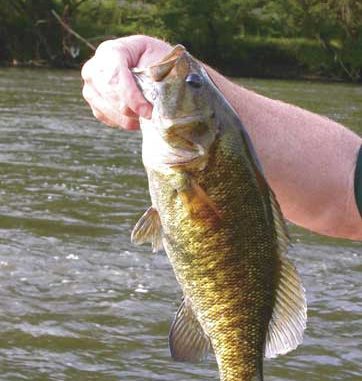
Most mountain fishing guides take their clients to smallmouth bass havens such as Fontana Reservoir or Lake Santeetlah, where a daily catch of 15 to 20 bass a day is considered a fine day.
Chris Manderson of Asheville prefers the French Broad River.
If he catches only 15 to 20 smallmouth, he considers it a poor day of fishing. A good day for him is 50 to 100 smallmouth, and he has many more good days than bad.
The bass are smaller, running, on the average, between one-half pound to 2 pounds, 10 to 12 inches, but the consistent action makes up for size. Even a half-pound smallmouth gives a challenging fight in river conditions. Frequently, the daily catch includes a smallmouth up to 4 pounds.
“That’s a big fish for the river,” Manderson said.
Manderson said this section of the river is loaded with smallmouth. He plies the river in a rubber raft, usually taking no more than two people per outing for a half day or full day. Unless the river is high and muddy, he can almost guarantee a fine day of fishing.
A native of Tuscaloosa, Ala., Manderson is in his fourth year as a fishing guide. Before that he was a professional kayaker, competing with the Perception U.S. team six times.
When he quit kayaking, he became a white-water rafting guide. The transition to river fishing guide was natural, utilizing his rafting skills and satisfying his love of fishing.
Unlike lake fishing, river fishing depends heavily upon water conditions. When the water is high and currents are swift, it’s not a good time to be on the river. Nor is fishing productive after a hard rain or thunderstorm. The river muddies up quickly, and good fishing ends. Ideal conditions are when the river is slightly dingy and low.
Manderson usually puts in at Woodfin, just north of the Asheville city limits, accessible from N.C. 251. This area has several riverside parks with boating access. This section of the river also is below the Asheville waste water and sewage facility, which may account, in part, for the large fish population.
“You catch fewer fish, but they’re larger,” said Manderson of conditions in the spring, particularly March and April, A day’s catch may include 10 smallmouth 16 inches and longer.
“I usually see one or two fish that size per hour,” he said. “Usually, they’re 14 to 15 inches.
“I see a lot of smaller fish, especially from June through August. Most of these fish are in the 10- to 12-inch range. I usually catch all the big fish the first half of the year.”
Manderson said there’s usually a lull in fishing from late August through September, “but fall fishing is very good,” he said, “usually through the middle of November.”
The very best fall fishing is in October.
“Then you have a feeding frenzy,” he said.
Fishing falls off again during the winter, December through February.
Manderson prefers small lures, spinners, crankbaits and buzzbaits.
“It can change day by day,” he said, so he experiments until he finds the right combination.
With clear-water conditions, Manderson prefers gold and silver lures. When the water is muddy, he switches to brightly-colored lures. He doesn’t use live bait and diligently practices catch-and-release, protecting the resource and his livelihood.
The key to river fishing, Manderson said, is to keep moving and to be aware of river conditions.
“You have to move fast enough to keep off rocks, but slow enough to fish effectively,” he said.
My outing with Manderson was on a late summer day. We put in below Woodfin about 8 a.m. and immediately began catching fish. Most of the bronzebacks were 10 to 12 inches, no lunkers, but we caught a couple in the 14-inch range.
After about 20 fish, I stopped counting and enjoyed the experience. Since we weren’t keeping fish, there was no point in counting.
I don’t know for certain how many we caught, but my fishing arm was sore the next day from casting and reeling in smallmouth. It was a welcome discomfort.
I had fished the upper section of the French Broad several times, catching some nice smallmouth in the 3- to 4-pound range. The fish were larger, but the numbers were much lower.
We fished about 2 miles of river, but it seemed much longer, mainly because of the width of the river, wider in places than a four-lane interstate. We were able to move from one side of the river to the other, covering much more territory than if we’d fished straight down river.
Fishing a large river such as the French Broad requires rafting skills; it’s no place for amateurs.
Manderson’s web address is www.whitewatersportsman.com. His e-mail address is chris@whitewatersportsman.com, and his telephone number is (828) 216-1336.




Be the first to comment